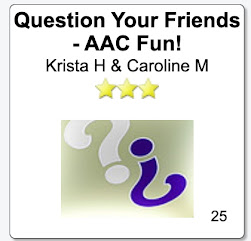What? Krista Howard and I are working on a series of short books to support teachers, therapists, and families who are supporting individuals who use AAC. These books are free to anyone, and have been 'published' at: www.tarheelreader.org. One of these books is titled Comments Are Cool.
This blog is a companion to the website, www.aacintervention.com At this site, my friends and I will be sharing quick posts, minitips, and think outlouds! Please visit frequently, as this site will change rapidly!
WELCOME!
Dr. Caroline Ramsey Musselwhite
Thursday, June 23, 2022
Comments Are Cool – AAC Fun!
Monday, June 6, 2022
Questions and Compliments – AAC Fun!
What? Krista Howard and I are working on a series of books to support teachers, therapists, and families who are supporting individuals who use AAC. The books shown are free to anyone, and have been 'published' at www.tarheelreader.com.
Why? These books are intended to painlessly support partners in helping students:
• Understand why these skills – giving compliments or asking partner-focused questions – are important and powerful (See Light and Binger, 1988, and Soto & Zangari, 2009 for more information). It is helpful for both teaching partners and individuals who use AAC to understand why we are working on these goals. Having cognitive clarity about goals helps people understand what we are doing, and what it will help them accomplish. These goals are shared through 'advice from Krista' speech bubbles, such as those shown below:

• Practice the skills we are sharing. Students get an opportunity to try the skills of complimenting and asking partner-focused questions through visual prompts, such as those shown here. In each case, the learner gets to practice, based on the image and the prompt.

• Examples of the skills we are sharing. Following each image, we give two examples of possible compliments / questions. This demonstrates that a range of compliments or questions are appropriate, and helps learners not to get 'stuck' with one specific sample.
Light, J. & Binger, C. (1998). Building Communication Competence with Individuals
Who Use Augmentative and Alternative Communication. Baltimore: Paul H.
Brookes Publishing Company.
Soto, G. and Zangari, Carole. (2009). Practically Speaking: Language, literacy, &
academic development for students with AAC needs. Baltimore, MD: Paul H.
Brookes Publishing Company.
Sunday, June 5, 2022
Tagging On for AAC!
• 'Will you go to the conference?' you might respond "Yes, I will.'
• 'Did you hear from Tanisha?' you might answer 'No, I didn't.'
• 'Do you have money for popcorn?' you might answer 'Yes, I do.'
Why Teach Tagging On? 'Tagging On' provides a powerful response to questions. It just means reflecting the language of the question in your response. For example, if asked:
‘Tagging on’ can support people who use AAC in the following ways:
• Show that the individual is listening (by using the language of the question);
• Demonstrate clear and powerful communication (showing the partner that this individual understands the questions, and has good communication skills);• More socially interactive than simply using a stark ‘yes’ or ‘no.’
• Provide a quick ‘placeholder’ while you think of a more extensive answer (e.g., for ‘b’ above, you might add “It looks great with your eyes.”)
More Info. More information is available on the Tagging On tip.
Download Tip # 2 for 2021 from www.aacintervention.com













